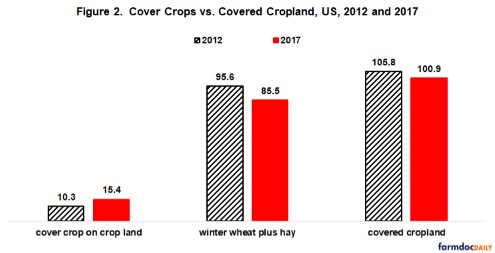By Carl Zulauf
Department of Agricultural, Environmental and Development Economics
Ohio State University
Gary Schnitkey and Krista Swanson et.al
Department of Agricultural and Consumer Economics
University of Illinois
Cover crops have environmental benefits, with many resulting from cover crops that over-winter, thereby absorbing nitrates in the early spring and building organic matter in soils over time. Because they over-winter, winter wheat and hay have many attributes ascribed to cover crops. Even though cover crop acres have increased, the increase has been more than offset by declines in wheat and hay acres, implying a step backward, not forward.
Wheat and Hay Acres: The 1996 farm bill eliminated annual set asides. With a few exceptions, farms were allowed to plant whatever was desired, most likely resulting in the rotation with the highest expected return. Since 1996, aces planted to winter wheat have declined by -41% (-21.0 million) while acres of all hay harvested declined by -14% (-8.8 million) (see Figure 1).
Cover Crops vs. Covered Cropland: According to the Census of Agriculture, 5 million more acres of cover crops were planted in 2017 than 2012 (see Figure 2 and Data Notes 2 and 3). This 5 million acre increase in cover crops was more than offset by a 10 million acre decline in wheat and hay acres, resulting in a 5 million acre decline in covered cropland. The decline in covered cropland is likely to be even larger. An unharvested small grain planted as a cover crop, such as wheat, is included in acres planted to the small grain. Acres of other fall-seeded crops, such as winter oats and barley, may have also declined.

Concluding Observations
Winter wheat and hay acres have many attributes portrayed as desirable in cover crops. Between 2012 and 2017, acres of winter wheat and hay declined more than acres of cover crops increased. In net, covered cropland acres declined by 5 million and thus took a step backward.
Unlike cover crops, winter wheat and hay generate environmental benefits while earning immediate economic returns. A winter wheat – soybean double crop rotation may generate environmental benefits while enhancing economic returns per acre. This observation led to a policy proposal to change the goal of US public research policy from enhancing yield to “growing 2 commercial crops per acre where 1 grew before” (see
October 28, 2020 farmdoc daily article). Seeking to cover more cropland more often with commercial crops potentially offers a rare win-win public policy by increasing US agricultural output while enhancing environmental quality.
The proposal raises important questions, including:
- What is the optimal rotation of crops in terms of economic returns and environmental benefits, including nutrient loading? For example, are environmental benefits and economic returns greater from planting 2 commercial crops per acre in a year or from planting 1 longer-season commercial crop plus an overwintering cover crop?
- What differential geographic impacts, if any, result from multiple commercial crops per acre vs. a commercial – cover crop rotation vs. current crop rotations?
Data Notes
- Principal crops are barley, canola, chickpeas, corn, cotton, dry edible beans, hay, oats, peanuts, potatoes, proso millet, rice, rye, sorghum, soybeans, sugar beets, sugarcane, sunflower, tobacco, and wheat. Planted acres include double cropped acres and unharvested small grains planted as cover crops. Harvested acres of hay, sugarcane, and tobacco are used as planted acres.
- The 2017 Census of Agriculture asked: “During 2017, considering the cropland acres on this operation, how many acres were planted to a cover crop? (Cover crops are planted primarily for managing soil fertility, soil quality, and controlling weeds, pests, and diseases.) Exclude CRP.” (Appendix B, page B-30). A cover crop could be the only crop or planted after a harvested crop.
- For more discussion of the cover crop data obtained by the Census of Agriculture, see the farmdoc daily article of July 24, 2019.